Induction lamps: device, types, scope of application + selection rules
Today, consumers are increasingly choosing energy-efficient household and industrial lighting devices.However, in addition to savings, the quality of the backlight also plays an important role. Induction lamps are a worthy alternative to traditional lighting sources.
They emit a soft light that is pleasant to the eye and does not change the objective perception of objects. Let's take a look at the design and operating principles of induction lamps together.
The content of the article:
Design and principle of operation
The primary light source in an induction lamp is plasma, artificially created as a result of ionization of a gas mixture by a high-frequency electromagnetic field.
The current generates an alternating electric field, causing the occurrence of a gas discharge in the glass flask. Excited mercury generates UV radiation, which is converted into visible light thanks to a phosphor.
Induction lamps belong to the category of gas-discharge lighting sources, more about which is written in this material.
The design of an induction lamp includes three basic functional elements:
- gas discharge tube;
- induction coil with ferrite ring;
- electronic ballast.
Inside the tube are drops of mercury amalgam. The flask itself is filled with a gas with low chemical reactivity - argon/krypton, and its inner surface is coated with an inorganic phosphor.
The induction coil and electromagnet form a high-frequency magnetic field, under the influence of which free electrons are accelerated, collide and excite mercury atoms.
The result is ultraviolet radiation. The phosphor transforms it into a visible bright glow.
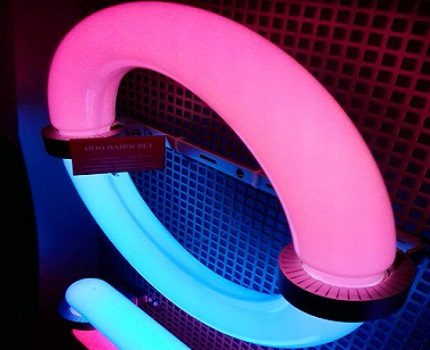
The electronic ballast is connected to a DC voltage source of 12 V/24 V or to a sinusoidal voltage network of 120 V/220 V/380 V.
The starter control system transforms 50 Hz alternating current into direct current, and then into high frequency current from 190 kHz to 2.65 MHz.
This RF current creates a magnetic field. In addition, the starter generates a strong starting pulse, which ignites the induction light source.
To ensure stable operation of the electrodeless lighting device, the control system can also change the strength of the electric current and its frequency through the inductor coil.
In order to reduce the scattering of high-frequency electromagnetic fields, lamps are equipped with ferrite screens and/or special cores.
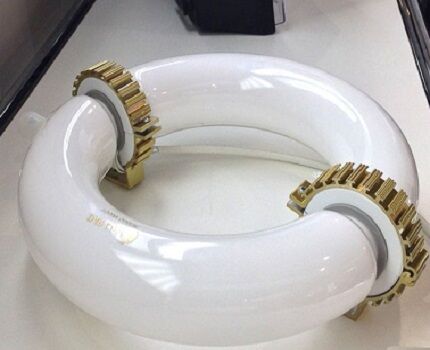
This makes the cylinder of the lighting device more uniform and approximately equally loaded in temperature.
With prolonged operation of such lighting, cracking of the glass bulb is not observed; over time, the electrode material does not deposit on the walls.
The absence of filament electrodes required to light conventional light bulbs allows induction lamps to achieve an incredibly long service life - up to 120,000 hours of operation.
Some manufacturers even claim a service life of up to 150,000 hours. This figure is 10 times higher than the durability of simple fluorescent light bulbs, gas-discharge HPDS, mercury-tungsten and sodium lighting fixtures.
In addition, the service life of induction light sources is approximately 2-3 times longer than the service life of LEDs.
Types of induction lamps
Nikola Tesla first demonstrated a lamp without contact electrodes back in 1893 at the World's Fair in Chicago. The lighting device presented to the public was powered by the magnetic field of a Tesla coil. And the first reliable prototype of an induction light source was created by John Melvin Anderson in 1967.
Classification of electrodeless light bulbs
In 1994, General Electric introduced the GENURA compact energy-saving lamp with a built-in high-frequency generator in the base.
Serial production of induction fluorescent lamps started in the 1990s.

Depending on the type of design, induction light sources are:
- with built-in ballast – the electric generator and lamp are combined in one unit;
- with a separate electronic starter - the external generator and the lamp are separated devices.
Depending on the way the coil is placed, these lamps are also divided into devices with an external (low-frequency) and internal (high-frequency) inductor.
In the first case, a coil with a ferromagnetic rod is wrapped around a cylinder. The operating frequency of lamps with external induction lies in the range of 190-250 kHz.
They have better conditions for intense heat exchange with the environment, since the coil outside the sealed flask easily dissipates the heat generated by the device. The service life of low-frequency devices is up to 120,000 hours.
In the second case, an induction coil with a wound core is located inside a glass bulb. The heat generated ends up in the cavity of the lighting device, which is why lamps with internal induction heat up more strongly.
Their operating frequency is in the range of 2-3 MHz. The resource of such light sources does not exceed 75,000 hours.
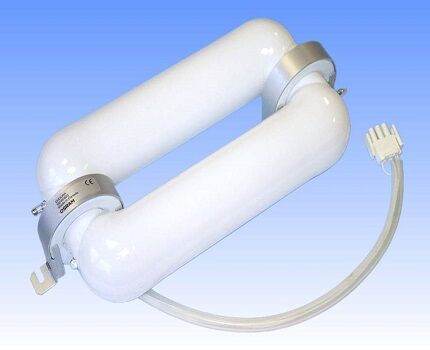
Both high-frequency and low-frequency lamps have a large safety margin and have a long service life.
Options and markings
Currently, companies that specialize in lighting have launched mass production of induction lamps of various shapes. Design features and design options can be seen in their markings.
The first two alphabetic characters in the code determine the type of device (IL - induction lamp), the third indicates the shape. After the letter designation, the power is usually announced.
ILK – round induction lamps.They have high luminous efficiency and a wide range of spectrophotometric temperatures. Suitable for installation in round and oval luminaires.
Such light sources are actively used to illuminate warehouses, spacious production and repair shops, shopping malls, and sports facilities.
ILSH – lamps in the shape of a ball. Made in the traditional form of conventional high-power vacuum lighting devices. They create a soft light and light up almost instantly.
Suitable for replacement incandescent light bulbs to energy-efficient light sources without the need to change the lamp itself.
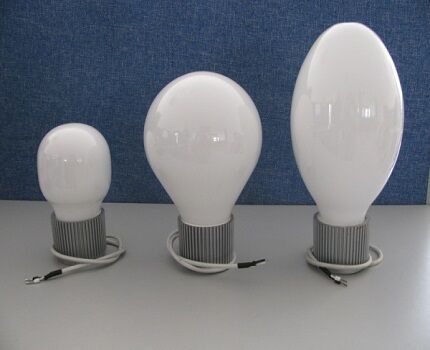
ILU – U-shaped light bulbs. They are devices with a separate generator. They emit bright white light and do not flicker during operation.
They are used to illuminate stadiums, tunnels, subways and highways, advertising stands, signs and other objects.
ILB, ILBK – lamps with a ring-shaped bulb. In them, the generator, coil and tube are combined in a single unit. They generate soft light that does not dazzle, light up quickly and easily at temperatures down to -35 °C.
Similar designs are used for illumination of hotels and shopping areas, park areas and public gardens, private garden areas.
It is worth mentioning separately about induction phytolamps for plants. They differ in the shape of the glass bulb and the color of the radiation.

Induction phytolamps GP and VG are intended for illumination of plants at the stage of vegetative growth. The blue spectrum of radiation predominates in them.
FL devices are used in the initial phase of fruit formation, as well as to accelerate the formation of flowers. They emit red light.
KL model bulbs are universal. Such light sources make it possible to control the growth of plantings. They generate rich red light, necessary for the full development of plant fruits and abundant flowering.
Marking examples:
- ILK-40 – round induction lamp with a power of 40 W;
- TILPVG-120 is a rectangular induction phytolamp with a power of 120 W, model VG for the initial stage of vegetative growth of plants.
The emission of an induction lamp corresponds 97% to the solar spectrum, and therefore is excellent for artificial lighting of greenhouse complexes.
Advantages of using IL
Electrodeless lamps generate soft light that is comfortable for the eyes. The shades of colors are not distorted.
The brightness of such lamps can be changed within 30-100% using a simple dimmer for devices with filament.

Even after 75,000 hours of operation, induction devices maintain a light power level of 80-85% of the original.
Conventional daylight LLs lose up to 55% of their brightness towards the end of their service life. Over time, dark, opaque circles form on their flasks.
Advantages of using electrodeless induction lamps:
- Efficiency 90%;
- service life up to 150,000 hours;
- light output more than 90-160 lm/W;
- optimal conditions for visual perception of objects;
- operating temperature range from -35 °C to +50 °C;
- color rendering coefficient Ra˃80;
- high energy efficiency indicators;
- minimal heating of the flask;
- unlimited number of start/shutdown cycles;
- no pulsation;
- the ability to adjust the intensity of the glow;
- The warranty period is 5 years.
Manufacturers claim that induction light sources have better technical characteristics than LEDs and are several times cheaper. The energy consumption of these types of light bulbs is approximately the same.
Application of electrodeless lamps
Modernized lighting devices that do not contain thermal cathodes and filaments are used for both indoor and outdoor lighting.
Scope of use of IL
Electrodeless lamps have built-in protection against short circuits (short circuits) and voltage surges.
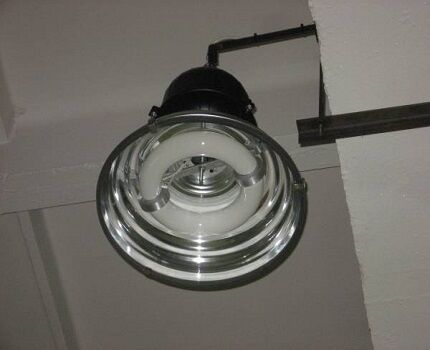
Due to their high luminous efficiency and low electricity consumption, they are used in various fields:
- for organizing high-quality street lighting;
- in shopping, entertainment and hotel complexes;
- in office centers and domestic premises;
- for lighting spacious workshops and warehouses at industrial facilities;
- for illumination of greenhouses and greenhouses;
- for lighting highways and tunnels;
- for organizing explosion-proof lighting at gas stations.
Due to the stability of their parameters, electrodeless mercury lamps are used as precision point sources of UV radiation in spectrometry.
In addition, the principle of inductive excitation of gas is used in the process of transferring energy from external sources into the working environment of lasers.
However, due to the presence of high-frequency electromagnetic radiation, induction lamps are not installed at railway stations and airports.
These bulbs can also cause interference when used simultaneously with ultra-sensitive laboratory and medical equipment. Therefore, it is not recommended to use them in rooms with such special equipment.
Street and road lighting
The most effective road lighting can be provided by street lamps with induction energy-efficient lamps. This type of illumination guarantees comfortable visibility for both drivers and pedestrians.
Road lamps have a durable cantilever mount and are mounted on poles, as well as standard supports. They are used to illuminate park areas and squares, streets and squares, highways and parking lots, embankments, and courtyards.

As an example, the instant start of lighting on highways in places where there is movement of cars and pedestrians.
In addition, a sensitive motion sensor can be combined with a programmable twilight switch.
The device is adjusted to specific light levels. If the light level is insufficient, the sensor will give a command to turn on the lamps.
The possibility of dimming allows the successful use of intelligent systems for effective control of street lighting.
By controlling the brightness of induction lamps using a power regulator and an astronomical timer, you can achieve real savings in electrical energy and also significantly reduce maintenance costs.
The introduction of intelligent systems makes it possible to control the state of lighting, measure and analyze data on the energy consumption of lamps.
Safe industrial light sources
The use of devices based on induction technology is a cost-effective solution for modernizing lighting systems of industrial enterprises.
Induction lamps are of high build quality and do not require regular maintenance. They significantly reduce electricity consumption and help improve production profitability.
Industrial lighting devices have a protection class of IP54, which allows operation even in dirty and high humidity conditions. They can be installed in unheated and poorly ventilated areas.
Tempered glass combined with silicone insulation reliably protects the case from foreign impurities and water getting inside.
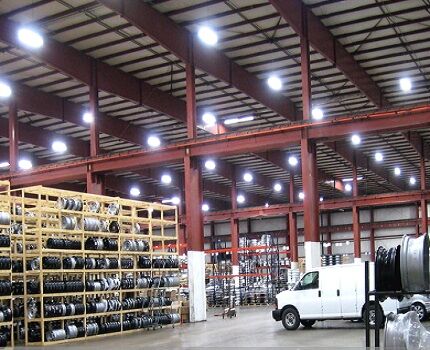
An antistatic polymer coating is applied to the body of induction explosion-proof lamps.
Thanks to this composition, lighting devices are characterized by impact resistance and resistance to sub-zero temperatures.
The special spark-proof coating does not deteriorate even in alkaline and acidic environments and can retain its properties for 30 years.
Lighting in greenhouses and conservatories
The spectrum of an induction lamp corresponds 75% to photosynthetically active radiation necessary for active growth and long-term flowering of plants.
That is why electrodeless light bulbs are used as additional sources in greenhouses and greenhouses, for lighting standard and compact grow boxes, direct, side and inter-row illumination of plants.
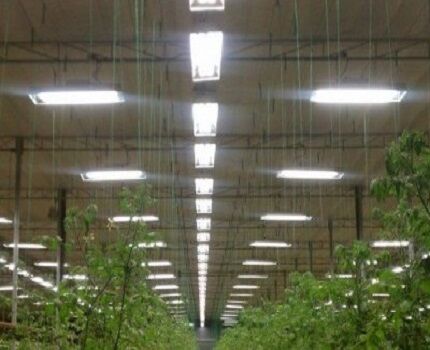
The use of such lamps in grow boxes makes it possible to significantly reduce the cost of cooling tanks.
The use of IL also allows you to pre-design and separately install lighting for each zone of the greenhouse.
To correct and direct maximum light to the desired sector, optical surfaces - screens - are used. They focus radiation on a specific area.
And with the help of special reflectors, artificial light is evenly distributed over the entire height of green spaces.
IL selection rules
When choosing induction lighting devices, it is important to take into account their design features, performance characteristics, as well as the degree of safety.
Only if this approach is followed can IL be considered a worthwhile acquisition.
Today in specialized stores it is easy to find electrodeless induction lamps with a power of 15 W to 500 W. But there are also more powerful ones, designed for various production needs.
Lamps with an oval bulb are available for luminaires with standard sockets E14, E27 and E40.
There are also special rectangular and ring types of induction lighting devices that can operate on both AC and DC power.

All induction lamps and electrodeless lamps undergo mandatory certification.
Therefore, we can speak with confidence about their safety. The amalgam is in a sealed flask and, subject to basic operating rules, its leakage is excluded.
However, you need to understand, like standard fluorescent lamps, induction lamps require appropriate disposal due to the presence of mercury compounds and electronic components.
Solid amalgam, an alloy of mercury with other metals, can be reused. The glass from the lamp is also recycled, but separately from the phosphor.
Lamps with induction technology are not environmentally friendly types of lighting and are much inferior to LEDs in this criterion.
It should be added that an induction-type light bulb does not immediately reach its stable luminous flux. At the start, it produces about 80% of the total radiation.
For this indicator to reach its maximum, an electrodeless lamp needs 2-3 minutes. During this time, the amalgam heats up sufficiently and the required amount of mercury evaporates.
Conclusions and useful video on the topic
Induction lamps are a new generation of gas-discharge lamps. The operating principle of this type of lighting:
What makes lamps induction, features of lamps of this type and scope of application:
Advantages of using modern induction light sources in industrial enterprises:
Correct installation of induction lamps in compliance with all standards and regulations allows you to effectively use energy-saving technology. Today, such light sources are a reasonable alternative to traditional approaches to organizing lighting.
Do you have experience using induction lamps? Or did you have any questions after studying the material? You can ask them in the comments block below the article. There you can share your experience or give valuable advice to visitors to our site.




I recently installed induction phytolamps for plants in a greenhouse. I chose devices in the blue spectrum so that photosynthesis would proceed normally. I also took into account that the lamp did not heat up too much and distributed the light evenly. I also looked to make sure it could work in winter and functioned normally at lower temperatures. In the end, the lamps were chosen, installed, the plants benefit from them, everything works.
Good afternoon, Maxim. Optimal conditions for photosynthesis are created by natural light. Spectally it corresponds to incandescent lamps. Professor A. Famintsyn studied the influence on photosynthesis of individual flowers in the 19th century. The result of the study is that chlorophyll, absorbing the extreme parts of the spectrum, does not react to yellow, green, and blue. In other words, you have created unnatural conditions for the plants.
I would be happy to purchase such lighting devices for my home, since for some reason ordinary energy-saving fluorescent ones burn out quickly for me. LEDs are reliable, but the light from them is somehow too harsh, lifeless, I just can’t get used to it. With a filament it turns out to be too expensive. But the current price, which is more than 1000 rubles. for an induction lamp, puts an end to the possibility of using it in everyday life.
Buy from large chain stores that provide warranties on lamps. I have seen induction lamps with a five-year warranty. Spending 1000 rubles every five years is not at all expensive.